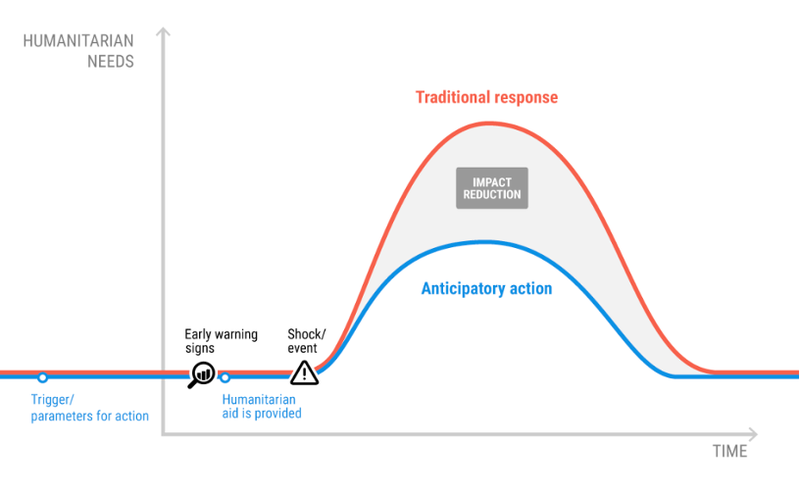Does Anticipatory Action provide innovativeness to Drought Risk Management?
AA sits between preparedness and response. ICPAC has been working towards implementing Anticipatory Action.

By Alexia Kioko
Anticipatory Action (AA) has gained prominence over time as a transformative approach in disaster management, garnering attention from humanitarian, development, research institutions, and regional entities like ICPAC. This innovative strategy diverges from the traditional response methods, where we wait and see what happens then decide on a course of action.
Looking at the Hyogo Framework and the Sendai Framework, AA sits between preparedness and response. ICPAC has been working towards implementing Anticipatory Action, as it aligns with the history of drought monitoring for the regional climate center.
Three things that need to be looked into are: the collaborative aspect of different partners, this will come in handy especially when acquiring and looking for partners. Having pre-agreed actions, for instance at GHACOF, is crucial; once general advisories are given, there need to be pre-agreed trigger thresholds that are defined for the different sectors which will define what happens once the threshold is reached. Lastly, there should be pre-allocated finances to create evidence and advocacy seen as a clear pathway to financial and resource mobilization to support AA: its contingency funding.
D2E is developing a Climate into Useful Water and Land Information in Drylands (CUWALID) model integrating anticipatory action where the risk levels will be added and used to develop different humanitarian actions. It will be revolutionary in managing risk as it will provide sector specific parameters like the water satisfaction index, which measures when crops reach their maturity level, this variable targets the agriculture sector. SPI, which measures wetness or dryness and targets the agriculture sector. Streamflow which targets the hydrological surface water management in hydrology. Another important variable is soil moisture, it will show the moisture content within the soil, and whether it can sustain the growth of key specific crops and pastures in the dryland areas.
Stakeholder collaboration will play a vital role in defining sector-specific thresholds which will transform GHACOF to have an impact based forecast information service which will support the development of AA. The future envisions advisories based on predefined trigger values once the pilot phase is over.
Discussion
Overcoming Funding Challenges:
The process of acquiring funds faces hurdles due to the probabilistic forecast that is the basis of AA. To address this a pool of evidence on why AA is important is being done, by showing government’s, investors and development partners that there is value in investing their money in AA compared to the traditional response.
Publications from organizations like FAO and WFP and WMO highlight the substantial cost savings. WFP has given ratios such as 1:7 USD where 1 dollar invested in AA saves 7 dollars and WMO gives a ratio of 1:6. With this in mind, it makes a compelling case for development partners donor investment. The critical bit is also that the forecast has to be very credible in terms of the thresholds and triggers for the forecasting information.
Strategic partnership:
ICPAC,a regional climate center, needs to have strategic partnerships with other organizations for the realization of AA integration. In order to acquire investments for humanitarian funding, there is a need to partner with a humanitarian organization. Funds will be acquired by working together with other actors who are well conversant with the field and are recognized by the donors.
Integrating Traditional Knowledge:
Kenya has decentralized its climate services to county level including working with traditional forecasters and communities to co-generate seasonal forecasts which is a good practice that should be emulated. Efforts to bridge the gap between cutting-edge technologies and tools and the last mile user such as the farmer include translating information to the local language, which hastens the action process. Utilizing trusted channels like radio for information dissemination.
Enhancing Local Engagement:
ICPAC is supporting member countries by working togethers with NHMS in downscaling information through participatory scenario planning (PSP) and other forms, to reach the local communities. The engagement with local communities encourages sharing of knowledge and experience as well as providing feedback.
Co-production:
This involves identifying the user, the users’ needs, and working with them to develop a contextual product. As ICPAC, there’s a need to strengthen the capacity to coordinate and ensure we can add value to the information that trickles down from the global producing centers to the regional and supporting the member countries to downscale this information.
Innovation for progress:
All in all, advocating for innovation and creativity is needed to improve on shifts such as from RCOFs to Climate Forum where sub-seasonal and seasonal forecasts are input into GHACOF. We could incorporate qualitative aspects into GHACOF where coproduction is being done and the impact of the thresholds are emphasized.
Anticipatory Action (AA) stands as an innovative approach to drought risk management, positioned between preparedness and response. ICPAC and national governments play a crucial role in facilitating the integration of AA in strategies and this can be done where various stakeholders are assigned clear roles and responsibilities.
The journey towards an effective Anticipatory Action requires not just financial support but a shared vision and commitment from diverse stakeholders. Communities could come up with their own drought response committees that work in tandem with national authorities and organizations to develop and implement anticipatory measures.
